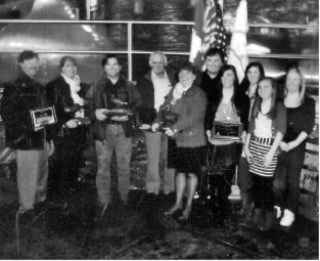On Wednesday Feb. 2 I received a phone call from Len Everet, B.C. director of Ducks Unlimited Canada. He was inviting me to a celebration of the genesis of Bear Creek Nature Park (161 acres) on the Oyster River and the creation of a conservation covenant granted by the Evans Family, owners of Shelter Point Farms, consisting of 357 acres of fields and environmentally sensitive foreshore on the Oyster River Estuary to Ducks Unlimited Canada.
The celebration took place at the new Shelter Point Distillery located on the farm. The accompanying picture of the Evans family has in the background one of the giant copper stills that will be used to produce single malt whisky in the future. I found it a particularly appropriate location for the conservation announcement and celebration of the day
One can only speculate about the momentous deals that have been consecrated in the shadow of whisky stills over the past few hundred years in the hills of Scotland, and now we can add the Comox Valley to such a worldly roster.
About 20 years ago when Elaine and I were touring Scotland I purchased a bottle of single highland malt Scotch whisky called Deerstalker. The only time anybody has a dram from this bottle is to celebrate a successful deer hunt. On the side of the box there is the following testament:
“The stalker spends his days – and some nights as well – on the high hills, watching over the herds of red deer that are native to these parts. His existence is solitary. Without even the companionship of a dog; his only company the creatures of wild places – the golden eagle, red grouse, mountain hare... The stalker lives with the weather in his face, often wet through by snow and rain, often chilled by icy winds. But he warms himself with a dram of “uisge beatha,” the water of life; his thoughts are elevated and the concerns of the city dwellers are not his.” - It is the appropriate goal of Shelter Point Distillery to produce the “uisge beatha”- single malt whisky.
The Evans family are farmers and well do they know the challenges the deer stalker faced in his daily routines because for generations they have met the challenges of farming in all the elements of our coastal climate. Their lifelong attachment to the land is a testament to their dedication of a sacred trust, caring for the land and all the creatures who depend upon it for survival. For in making these conservation treasures and trusts priceless gifts are given to future generations of British Columbians.
The symbolism of the great copper pot still in the background is profound. For years the creative wheeling and dealing that has gone on in the great pot still of conservation and ecological negotiations that percolated under the surface, brought this conservation event to fruition. Key players have been Ducks Unlimited Canada, the Evans family, Government of Canada, Comox Valley Regional District, Pacific Salmon Foundation, and private donors. Other silent partners in these ecological significant milestones were North American Waterfowl Management Plan and Wetlands Conservation Act, U.S. Fish and Wildlife Service and Habitat Conservation Trust Foundation.
Woven in the fabric of all these subtle negotiations are the members of the Oyster River Enhancement Society and other individuals that kept the pot boiling on behalf of the fish, birds, animals, and forest that could not speak on their critical needs. Thank you. Bear Creek Nature Park and Shelter Creek Farms Conservation Covenant are indeed cradles of the “waters of life.”
It is occasions such as this that give us pause to reflect on the importance of the seemingly endless number of conservation fundraiser banquets and auctions that we have throughout the Island. These types of projects would not be possible if it was not for the generous support the public gives to these events.
